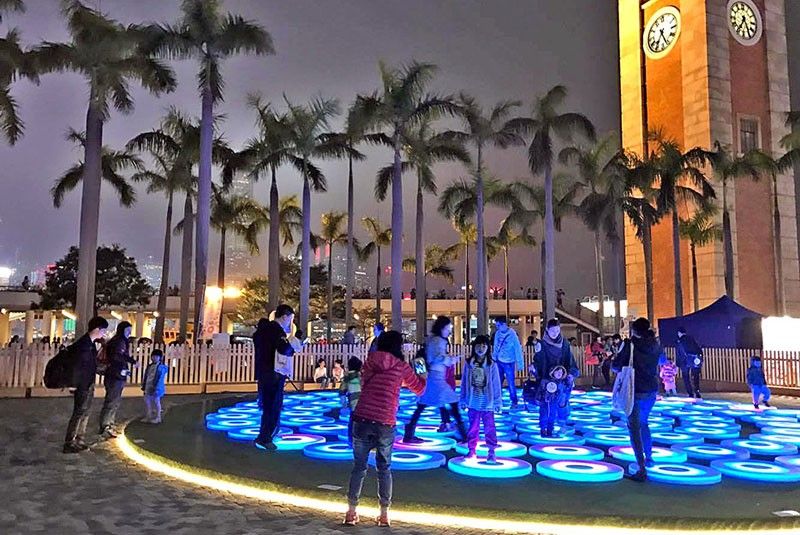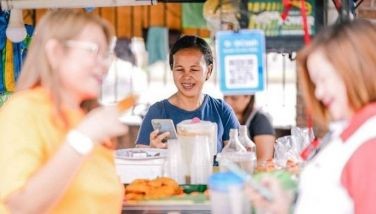Hong Kong’s factory town is its newest arts hub

I don’t know where I’m going but I promise it won’t be boring. Possessed by the spirit of a Bowie quote, I took the Hong Kong MTR for the first time in five years to a location little known to tourists. Mobile map in hand, I boarded the South Island Line from Admiralty and headed for Wong Chuk Hang, just one station shy of Ocean Park. Before December last year, my destination didn’t exist — the station, I mean. Having just recently opened, people, even locals, are still getting to know all about it and its brand-new ticket dispensers. The destination itself, Wong Chuk Hang, is only starting to get attention itself. In Hong Kong, a district without an MTR stop is a district without 7-Elevens and Sasas, as I later on discovered.
I arrived at Wong Chuk Hang at lunchtime, two hours before my scheduled tour: a visit to local art gems that only Hong Kongers know, courtesy of South Island Cultural District’s executive chairman Dominique Perregaux, and Hong Kong Tourism Board’s Vivian Li and Vivian Lai. With lots of time to spare, I attempted to walk around to look for a cute place to eat — experience tells me there are a lot of these in Hong Kong. But it turns out, Wong Chuk Hang is very different from my basecamp for this trip, Central.
Wong Chuk Hang station is in a gray area in Hong Kong. Literally, the area is all gray, save for a few new glass-walled buildings that are still in construction. But there’s more to the town than meets the eye. This factory town in the south side of Hong Kong Island is a new center of style and creativity — a center for hipster creatives, I was told. Now where exactly do these hipsters eat?
After circling two blocks, which include several construction sites, and an intimidating, very authentic Chinese restaurant, I exit a football stadium and find myself in a caffeine mecca — a building with four different hipster-looking restaurants on its ground floor. I pick one and rest. I wonder where all the people are coming from, considering I didn’t see a single person while I was walking around aimlessly. Wong Chuk Hang has an I Am Legend vibe to it. A concrete-jungle-where-dreams-are-scary-and-about-zombies vibe. A tourist visiting the place for the first time, like myself, may want to turn back and return to vibrant Central, Tsim Tsa Tsui, or Sheung Wan. After my day-long tour around the town, I can say turning back on Wong Chuk Hang would be turning your back on adventure.
“Every two buildings there is a new building in construction,” Perregaux told me. He took us (me and the lovely Vivians) to an overpass so we could see just how industrial the city is. “But this is also where the big fashion houses have their factories. And of course, this is where the new art galleries are.” That was the core of our tour, four of the 26 new galleries that found their home in Wong Chuk Hang. Accoring to him, gallery spaces at, say, Central, cost so much more, have low ceilings, and tiny elevators. “Not good for an art gallery,” he said. “In Wong Chuk Hang, it’s only 10 to 15 HKD per square foot.”
The first gallery that we visited proved his point. It was in a building that, judging by the industrial plastic that hung from one of the entrances, was a warehouse of some sort. We took an old but huge freight elevator (which can fit art installations) to Art Statements, which Perregaux owns. On exhibit that day was Patrick Lee’s “Tis Dark and Darker Still but Dark No More,” but they were also preparing for Art Basel, where they exhibited Japanese artist Yoshitaka Amano’s “Deva Loka Origins” (ongoing at Art Statements until May 20).
We proceeded to more galleries after. All huge with high ceilings and dodgy but spacious elevators that all seem to be rolling crates and canvases in and out. Among these galleries are Pekin Fine Art, Rossi & Rossi (where Filipino artists like Dex Fernandez have been featured), Infinity Gallery and Isho Japanese Gallery, all in Wong Chuk Hang. Discovering these hidden gems was like being in a video game. The fun was in going through buildings to get to another building, going into their basement parking lots and finding their elevators, figuring out which door of the many identical looking doors held the art we were looking for.
Last March 23, South Island Cultural District held Art Day, during which tourists got to discover these galleries on their own with the help of only a map and a wristband to identify each other. I wouldn’t have survived that, but judging from experience, I imagine it was fun. I walked a total of 18,335 steps that day. I returned to my hotel in Hollywood Road, one-year-old boutique hotel Madera, and felt sufficiently artsy.
Old and new at Sheung Wan and Central
Hollywood Road is at once my favorite and my least favorite road. The pros: Lots of restaurants, bars and cafés. Perennially alive. Very near the Central Mid-Levels Walkway. Inhabited by cool transients. The cons: Literally an uphill and downhill battle — hard on the knees. Not a lot of taxis. Inhabited by too-cool transients. But it is one of the most convenient locations for a tourist. It’s right behind PMQ and is also only an eight-minute walk to Sheung Wan, an interesting new district that seems to be interested in crafts: craft beer, flower arrangements, craft teas, and décor. Find Tai Ping Shan street when you visit. It’s a nice place to hang out.
Living in the Central area would not be complete without kicking it old school. Walk Hong Kong’s Olivia Tang and Paul Chang took us around the area, first for some Chinese medicine oddities at Pak Cheong Tong (a store that’s been around for 100 years, selling stuff like antlers, sperm whale secretions, caterpillar fungus and bear bladder).
We visited the Hundred Surname Temple, an ancestral hall of worship, which, 150 years ago, held all death records. The Chinese believe in the saying “Fallen leaves should return to its root.” The temple was once a place where families could claim their loved ones and bring them back to their hometowns so they can attain peace.
And the best part: Egg tart at Tai Cheong Bakery and sugar cane pudding at Kung Li Sugarcane Shop (not to be confused with K’un Lun, which is where Iron Fist trained — if he did train here though, I’m sure he misses the pudding).
After my tour, HKTB treated us to a performance of The Beauty Queen of Leenane, a play written in 1996 by Martin McDonagh about Maureen Folan (Aisling O’Sullivan) a woman in her early 40s and her manipulative mother Mag (Marie Mullen). Dubbed as a dark comedy, it was indeed dark and hysterical at times. A must-see if you love theater. It’s also something you’d appreciate, even if you don’t.
Sake and lights at Tsim Tsa Tui and Ocean Park
The best way to end a long day of walking is with alcohol and a plate of grilled kobe beef. Ocean Park’s ongoing Chill Out @ The South is a true attraction for world weary adults. Held until April 17 over 19 select evenings, Chill Out is part of the Park’s 40th anniversary celebrations. For HK$168 after 5 p.m., you can enter Ocean Park and indulge in food and drinks and, well, chill out.
I dropped by on sake night. But as I might be allergic to sake, I opted for a tall glass of craft beer. For those visiting soon, it’s Pop & Rock Beer Fest until April 4 and April 7-9, and In the Taste of Excellence from April 13-17. For information, visit oceanpark.com.hk.
Alas, my day wasn’t done after my beer. After a well-won battle with the public at the MTR station during rush hour, we went to Tsim Tsa Tui to view the last night of Superpool, an interactive lights installation by Jen Lewin, right across Hong Kong Cultural Center. As part of Hong Kong Arts month, Lewin’s piece traveled all the way form the UK to entertain kids, their parents, and some very silly looking adults. You step on a “button,” and it triggers a reaction across the entire piece. There were so many children, myself included.
Just when Hong Kong is starting to feel like an old neighbor too familiar to pay attention to, it comes home with blonde hair, a nose ring and some kobe beef. You’ve got our attention now.
* * *
Special thanks to Hong Kong Tourism Board, South Island Cultural District, Hong Kong Ocean Park, Walk Hong Kong, and Cathay Pacific. For information on what’s new in Hong Kong, visit www.discoverhongkong.com.



















